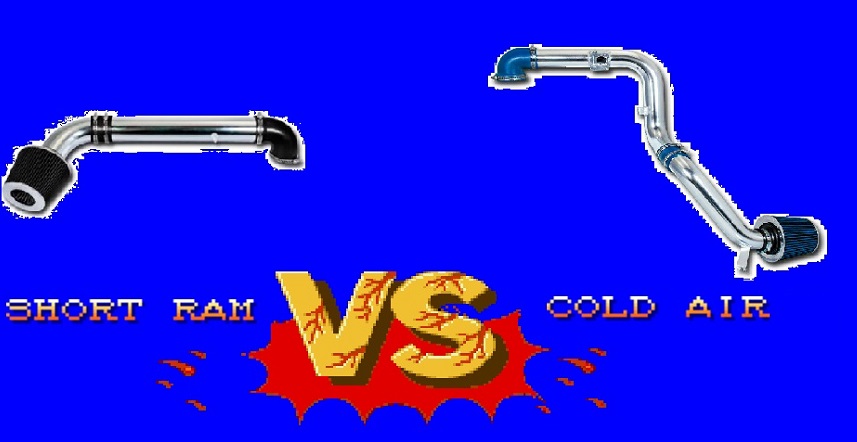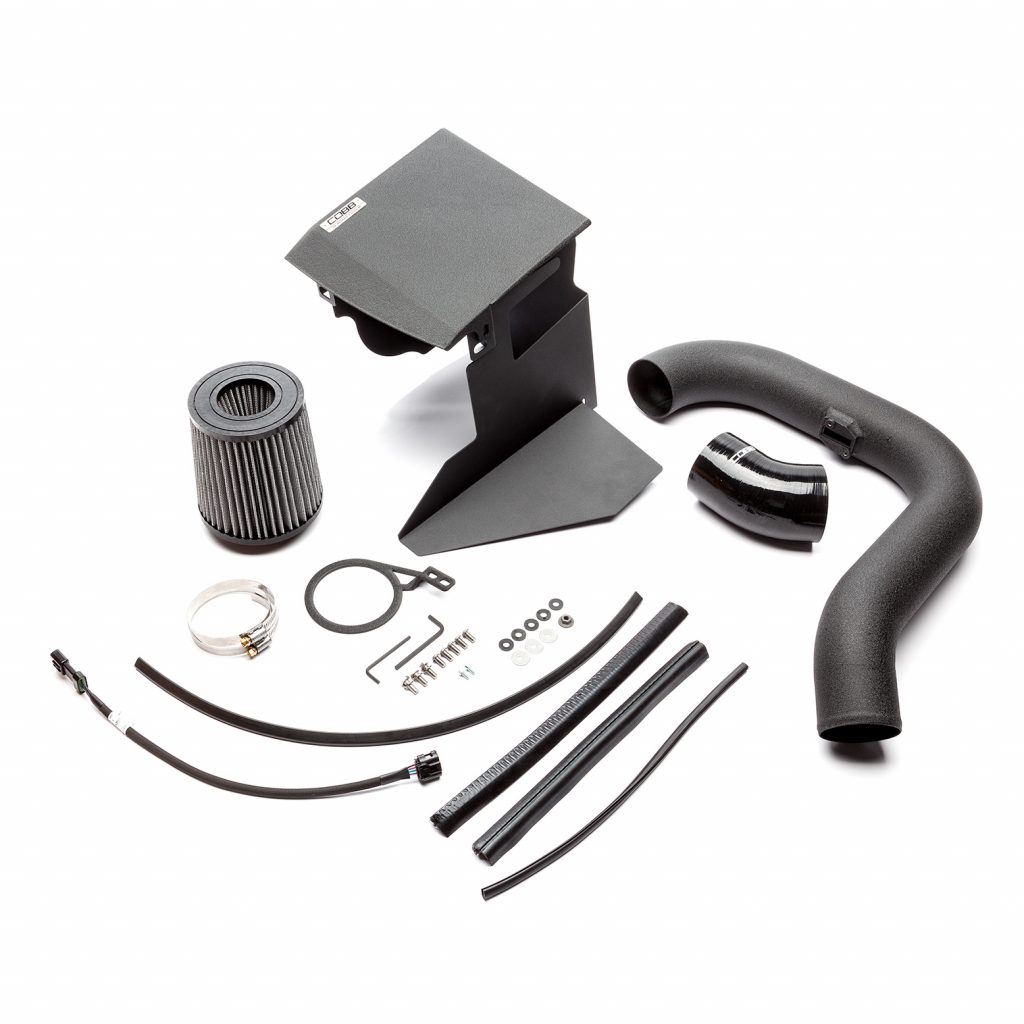Difference Between Cold Air Intake vs Short Ram Intake
Difference Between Cold Air Intake vs Short Ram Intake

Most of us already know about the Types of Air filters for Cars but what about the intake? When it comes to aftermarket intakes, they typically come in one of two varieties. Here we’ll consider the difference between cold air vs short ram intakes. But first, let’s cover what the intake does and how it does it.
As you might have guessed, the intake is responsible for taking air into the engine. It starts with the air filter, goes through the intake, and will then go through the throttle body on a naturally aspirated car or into the turbo inlet hose on a turbocharged car (see How to Get More Out of Your Air Intake System on Turbo Cars: Upgraded Turbo Inlet Hoses). In either case, if the engine is running, this intake side is under vacuum which pulls air into the system for combustion.
The goal of each intake is to provide additional horsepower. Each goes about it in a slightly different way (hint – the name says it all).
Cold Air Intake
Air. It’s a significant part of the recipe that gives us the right pedal induced joy. But, not all air is created equally. When it comes to air, the amount of oxygen it contains is critical in terms of combustion. Air that has higher oxygen content (which can be had through adding a nitrous system) allows more fuel to be burned. But, you are able to increase the amount of oxygen in the air entering the intake without nitrous. How? Temperature! Since colder air is more dense, it contains more oxygen and allows the potential for more fuel. Thus the potential for more power. The Cold Air Intake is built on this premise.
The cold air intake achieves this by relocating the engine air filter outside of the engine compartment in an effort to take in cooler air. Not only is it out of the engine compartment but it is typically placed at a point low to the ground. The benefit here is two-fold. Firstly, since heat rises, it avoids the hot air rising from the engine bay, brakes, or any other heated component.
Short Ram Intake
As the name implies, the short ram intake is not very long. In fact, this attribute defines how this style of intake can be beneficial. The goal with the short ram intake is to direct air into the engine in the shortest route possible. The shortest route is also straight. These characteristics combine to create a path that has the least amount of resistance for air to get into the engine. This lesser the resistance, the more air you have, thus the more horsepower potential.
Cold Air Intake vs Short Ram Intake
There are a lot of Cold Air Intake Pros and Cons as well as pros and cons to the short ram intake. The cold air intake does get denser air than the short ram intake. However, since it is longer and more complex, it is often more expensive. This increased complexity also leads to a more difficult and time-consuming installation. The greatest benefit to the cold air intake can also be it’s greatest weakness; the location of the filter. Having a low-placed filter outside of the engine bay is great for taking in cooler, denser air. But, that location is also where the most debris and moisture are also present. If your intake ingests a significant amount of water, it doesn’t matter how beneficial it has the potential to be as your engine will soon no longer be running.
The strength being a weakness can also be said for the short ram intake. Although its placement will prevent water ingestion, it also is affected by heat soak due to being in the warm engine bay. Is there a best of both worlds? The goal of the COBB SF Intake and Airbox combo is just that.
COBB SF Intake and Airbox

If you’re thinking of which car mods to add, the COBB SF intake and integrated airbox looks great and has the combined benefits of a short ram intake and a cold air intake without any of the negatives. This system utilizes several unique features in an effort to maintain optimal flow for performance while minimizing turbulence that can cause engine management problems. It uses a custom conical cloth air-filter element and a CFD-designed velocity stack leading to a unique airflow straightener grid. This straightener grid is specifically designed to smooth the incoming airflow as it passes the Mass Air Flow sensor for precise readings. This eliminates the “dead spots” experienced by other aftermarket intakes due to turbulence. Most other aftermarket intakes do not utilize these critical design elements.
In order to provide a system that looks as good on the outside as the technical advancements happening on the inside, we utilize a one-piece design constructed from a high-temperature plastic composite. Not only does this save weight compared to the previous metal design, but the plastic composite material also offers much better heat rejection properties that help keep intake air temperatures cooler. In contrast, intake systems constructed using metal castings or piping can actually retain underhood heat and in turn heat the incoming air.
The SF Air Box adds the benefits of a cold air intake to the outstanding performance of the SF Intake. The factory inlet directs cold air from the front grill to the SF Air, which encloses the SF intake. Hot engine bay air that robs horsepower is prevented from entering the intake system. This unique design also separates rainwater from the intake air, eliminating the water ingestion issues that plague in-fender cold air intakes. Calibrations by way of off the shelf maps on the Accessport have you covered for any necessary tuning changes.
Choosing the Right Intake
The intake is the front-line of your engine’s operations. It intakes the air and distributes it to the engine. If there is a restriction here, an upgrade can yield some significant power gains. Fortunately, for most vehicles, especially those that are factory turbocharged, the intake tends to be fairly well designed from the factory. This means that power gains are typically negligible unless additional significant modifications are added which require airflow beyond what the factory intake can provide. So really, if more power is your goal, any upgraded intake can be “right.”
But, even with that in mind, the intake still looks and sounds incredible. Most enthusiasts don’t realize just how much louder the intake can be. If you’re converting a closed box intake system to an open filter, you’ll definitely hear the difference.
As if that weren’t enough, an upgraded aftermarket intake can actually save you money! The COBB SF intake comes with a reusable filter that will last the life of your vehicle. Most users typically wash and re-oil their filter annually or every ~12k miles. Your mileage may vary depending on the conditions your vehicle operates. In any case, most upgraded intakes will have these types of filters. If power and noise aren’t benefit enough, you’ll never have to buy a new filter again!

Quick question, if you purchase the sf intake with box and run the access port with it. Are you still able to run a catback exhaust with it? Sorr, this is for a 2018 subaru wrx sti. Just wondering because when trying to choose a ots map, once the air box is highlighted the cabacm exhaust option turns gray.
Hey Justin,
Since an upgraded cat-back exhaust does not require any specific tuning changes, you can use our Stage 1+SF OTS maps for your 2018 STI with an upgraded cat-back exhaust without issue.
Marshall@COBB
I got a 1994 Chevy Silverado 350 Tbi. I have no cats and true dual flowmasters. I was wondering which intake would sound better and add the most horse power from my factory intake
-Thanks
Hey Justin,
I don’t think an intake would do much for power. You may be able to get a couple of extra ponies from colder air if your current intake is drawing from the engine bay. Anything intake you use where the filter is open will be louder.
Kyle@COBB
Which intakes would be best for a 2014 Lincoln mkz?
Unfortunately we do not offer an intake for the MKZ, sorry!
Marshall@COBB
Hello I have a 2017 Nissan Sentra Nismo. I have a full cold air intake and cat back exhaust. But have been having problems with rain/water. What is my best solution for this? Thanks.
Hey Daniel! We don’t have any vehicle specific suggestions for you. It’s always good practice to ensure the filter is protected from water intrusion.
Marshall@COBB
Which Intake would be best for 2011 mitsubishi lancer es ?
Hi Christian! Unfortunately we do not offer an intake for that car and thus do not have much information.
Marshall@COBB
I have a 2017 Mitsu Lancer SE. i have a short ram intake, do you guys tune base lancers or only have maps for evolutions? Trying to draw a little more power.
Hey there! We do not offer any tuning support for the base Lancer, sorry!
Marshall@COBB
Hey so if I got a sri for my g6 which I’m looking just to put a couple mods under hood and a couple cosmetic mods to make it feel like home, do I need a tune for the short ram intake?
Hey Ben, we are not familiar with that platform. In general, that will depend on how the intake was developed and if it is compatible with the factory calibration. We would recommend reaching out to the company you purchase the intake from for those details.
Marshall@COBB
I have a 2011 sti. It has a K&N (red pipe) cold air intake. I currently have a basic stage 1 map on it. I’m wondering if Im able to run the cobb SF stage 1 map with it or do I need the sf intake?
Hey there! The K&N Intake really needs specific tuning in order to safely run on the STI. We would recommend using the factory intake with our Stage 1 Off The Shelf Maps or swapping to an SF Intake and using our Stage1+SF maps.
Marshall@COBB